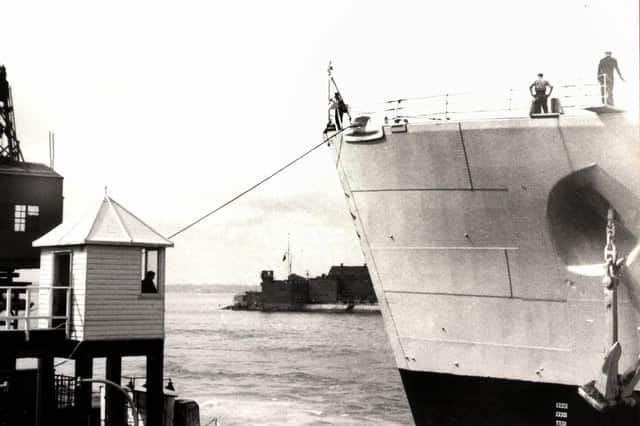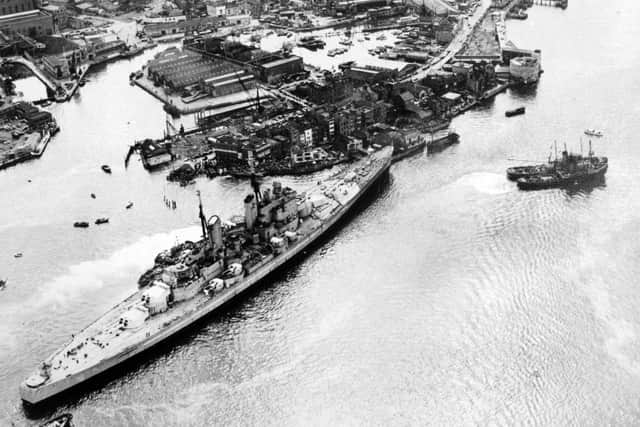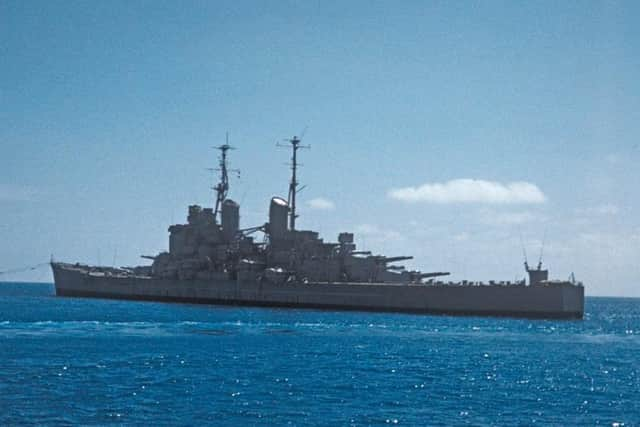HMS Vanguard - pilot's quick thinking prevented carnage | Nostalgia


Tim King writes: Most of Alan's memories are spot on and his dramatic description of the Royal Navy’s last battleship going adrift in the Channel is a revelation, but I must pick up on some details.
From my vantage point on the bridge, I watched Vanguard begin to veer to starboard towards No1 mooring buoy soon after we got under way and long before she approached the Still & West.
Advertisement
Hide AdAdvertisement
Hide AdSenior pilot Roy Otley – undoubtedly the hero of the hour when his split-second action to order first the starboard then the port anchors to be dropped where the flukes hooked on to the old floating bridge chains to drag the ship away from the Still & West and certain carnage – counteracted the swing by bringing the forward towing tugs Antic and Capable to the port side.


But they lacked the power to deal with the 44,000 tons of ‘dead ship’ and she then began to veer to port.
I was taking exclusive pictures on my camera right from the start of the tow and one of them clearly shows the battleship’s bows veering to port towards an aircraft carrier (I believe it was HMS Centaur) berthed at North Corner.
It was obvious even at that early stage that the tow was in deep trouble as Antic and Capable had already crossed back to the starboard side. Their hawsers were straining in a vain effort to shift Vanguard back on course.
Advertisement
Hide AdAdvertisement
Hide AdMy photo gives a panoramic view of the harbour entrance and Spithead.


It also shows the Cunard liner Queen Elizabeth passing en route from Southampton to New York – and there are no sea-going tugs yet in sight.
My information from the Assistant Queen’s Harbourmaster, Commander West, was that the planned changeover of hawsers between harbour and sea-going tugs was not supposed to happen until after the battleship had cleared the entrance.
Looking at the famous aerial photo taken by Evening News chief photographer Roy West it is difficult to see what effect RFA Advice could have had to influence the inevitable grounding as she was firmly secured to Vanguard’s port side amidships.
Advertisement
Hide AdAdvertisement
Hide AdI question Alan’s claim that Vanguard didn’t go aground. She drew 28ft below the waterline at her bows and later Queen’s Harbourmaster Captain B Pengelly told me: ‘The ship was lightly bedded in about 12 inches of mud and as soon as the big tugs from Spithead applied their pull to the stern she came away easily.’ Undoubtedly, the anchors had prevented the bows slicing deep into the seabed.
Just before Britain’s last and most powerful battleship disappeared over the horizon for good, AQHM Commander West took a look around the bridge and into the chart house, now a shambles of torn cables and rusting plates, and recalled sadly: ‘Spent many a night there.’ He had been Vanguard’s navigating officer and had seen the last firing of her 15-inch guns.
Vanguard eventually made it to the warships' graveyard at Faslane after the drama off the Cornish coast.
However, the Queen Elizabeth-class battleship HMS Warspite (32,000 tons), which fought at Jutland in the First World War and had a distinguished Second World War record, defied her executioners there for eight years.
Advertisement
Hide AdAdvertisement
Hide Ad'She left Portsmouth towed by two sea-going tugs on April 19, 1947, for Faslane.’
But she ran into a severe storm and the hawser of one of the tugs snapped – ironically it was Bustler which was 13 years later to speed in from Spithead to help end Vanguard’s 45-minute reprieve and then form one of the trio hauling her to her doom – and the other tug, Melinda, had to slip her cable.
Warspite was first driven ashore at Cudden Point, refloated herself and then went hard aground in Prussia Cove. Several salvage operations failed and she was beached off St Michael’s Mount where she finally disappeared under the ship breakers’ blow torches in 1955.
CAMPING TRAMS
My recent photograph of the camping trams on Hayling Island was seen by Richard Newman who tells me the photographs were from about 1948.
Advertisement
Hide AdAdvertisement
Hide AdHe says the white trim under the bumper is a reminder of the blackout during the London blitz.
Richard believes that one of the trams ended up somewhere in the Meon Valley where the top deck was removed.
However, the bulk of the vehicle ended up at the Crich Tramway Museum in Matlock, Derbyshire, where the top floor was replaced.
Comment Guidelines
National World encourages reader discussion on our stories. User feedback, insights and back-and-forth exchanges add a rich layer of context to reporting. Please review our Community Guidelines before commenting.